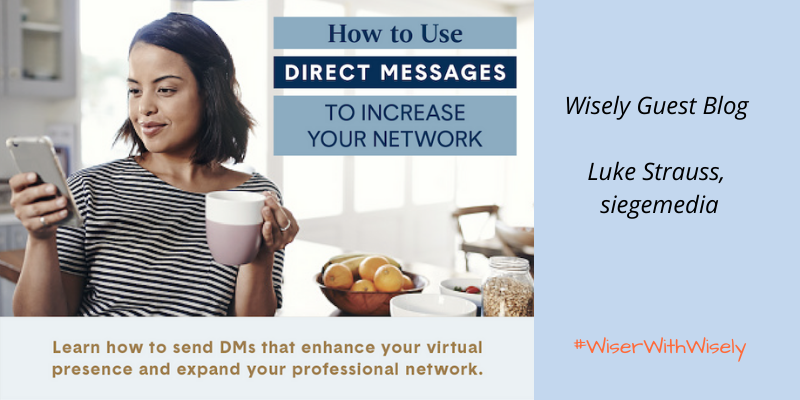
Any outreach, and especially outreach for fundraising, can be challenging. Aside from worries about personal rejection, it’s difficult to know what phrasing and communication strategies will elicit the most positive responses.
While email is a great tool that has been used for decades to conduct outreach, as the digital age progresses, we’re seeing a greater and greater shift toward direct messaging. Indeed, LinkedIn InMail senders now achieve a 300% higher response rate than emailers. If you’re looking to step up your Direct Messaging (DM) strategy to conduct effective outreach, you’ve come to the right place.
Before starting to craft the perfect message, there are some considerations and best practices that you’ll want to keep in mind. Let’s jump right in.
Know Your Platform
The internet is home to countless apps and platforms, each with its own unique etiquette for messaging a stranger. Before you start writing, you’ll want to ask – what’s the tone of the platform I’m using? Is it casual? Professional? Something in-between?
While you may start a conversation on Instagram or Facebook by complementing your recipient with casual language and expressive punctuation, this style may not float as well on more professional networking platforms, like LinkedIn or an equivalent.
While it’s perfectly fine to be friendly when using a more professional platform, it’s important to avoid getting carried away. A good rule of thumb is to use no more than one compliment and a single exclamation point in your initial message – anything more could come across as excessive or unprofessional.
Do Your Research
It’s especially important to have a basic understanding of your recipient’s work and background if you plan to ask them for money. What do they care about? What does their organization do? Have they written anything you’ve enjoyed or appreciated?
Not only will research provide you with some ideas for valuable conversation starters, but it will also help you effectively communicate how you align with your recipient’s interests. Research will reveal how much experience they have in certain fields so you can adjust your language accordingly. Maybe you’ll even learn about some pain points they’re experiencing that you could help solve – a value proposition that will certainly grab their interest.
Personalize
After you’ve taken some time to get to know your recipient through research, you’ll have an arsenal of information that can be used to personalize your direct message. Did you attend the same school as your recipient? Does their profile show that they share a common interest with you? Point it out! Remember, outreach is relationship-building, and making a personal connection will benefit you in the long-run.
As tempting as it is to save time, it’s a good rule of thumb to avoid sending a generic copied & pasted message when conducting outreach. People like to believe the message they receive is unique to them. When you personalize, you will likely receive a far higher response rate.
Be Straightforward
When sending the first message, it can be tempting to start with several sentences of introduction before getting to the “meat” of the message. However, it’s important to remember that donors and other professionals are often operating on a time crunch and might ignore or even delete your message if they don’t see your main point right off the bat.
For this reason, it’s important to keep pleasantries to a minimum, keeping your message brief, specific, and to the point. After a quick introduction and a bit of personalization to capture interest, get right to your request – your entire message should be no more than four or five sentences. If they respond with interest, that’s when you can be slightly more relaxed and fill more space.
Remember, a great deal of traffic on platforms like LinkedIn comes from mobile devices, where messages look a lot longer than on large desktop screens. When in doubt, send a practice message to yourself and see how long it looks on your smartphone. If you find yourself scrolling, you might want to cut down a bit.
Do a Gut Check
Before you press send, it’s important to do a last-minute gut check, reading over your message and asking yourself a few questions: Would I say this in the workplace? Does my message flow well? Do I sound too pushy or overbearing? Would I respond to this message if it came to my inbox?
If you have any doubts when asking these questions, you can expect your recipient to feel the same. Go back and edit until you feel confident you have a reply-worthy message!
Follow-Up
If your recipient hasn’t responded in four or five days, you may wonder whether it’s appropriate to follow up. The answer? Absolutely! Following up is encouraged as long as you are respectful of your recipient’s time and give them several days to respond before sending your first follow-up message. If they don’t respond after that first follow-up message, it’s probably a good sign to give them some space and potentially return at a later date.
One of the biggest fundraising mistakes people make after a request has been fulfilled is forgetting to say two simple words: “Thank you.” If you not only receive a reply to your direct message but a willingness to help out, it’s critical to send a message thanking your recipient for their time, generosity, and/or assistance.
Whether you’re about to conduct an outreach campaign or introduce yourself to a recruiter, hopefully, you’ve taken something valuable away from these tips. If you’re looking for some additional guidance, check out Tommy John’s visual below with some templates to help you send the perfect direct message. Finally, remember to choose Wisely to enhance your donor relationships and make your fundraising efforts as effective as can be.
Click on the link below to watch Wisely in Action 🙂